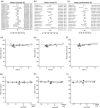Developmental outcomes after early surgery for complex congenital heart disease: a systematic review and meta-analysis
- PMID: 32149404
- PMCID: PMC7754445
- DOI: 10.1111/dmcn.14512
Developmental outcomes after early surgery for complex congenital heart disease: a systematic review and meta-analysis
Abstract
Aim: (1) To systematically review the literature on developmental outcomes from infancy to adolescence of children with complex congenital heart disease (CHD) who underwent early surgery; (2) to run a meta-regression analysis on the Bayley Scales of Infant Development, Second Edition Mental Developmental Index and Psychomotor Developmental Index (PDI) of infants up to 24 months and IQs of preschool-aged children to adolescents; (3) to assess associations between perioperative risk factors and outcomes.
Method: We searched pertinent literature (January 1990 to January 2019) in PubMed, Embase, CINAHL, and PsycINFO. Selection criteria included infants with complex CHD who had primary surgery within the first 9 weeks of life. Methodological quality, including risk of bias and internal validity, were assessed.
Results: In total, 185 papers met the inclusion criteria; the 100 with high to moderate methodological quality were analysed in detail. Substantial heterogeneity in the group with CHD and in methodology existed. The outcome of infants with single-ventricle CHD was inferior to those with two-ventricle CHD (respectively: average scores for PDI 77 and 88; intelligence scores 92 and 98). Perioperative risk factors were inconsistently associated with developmental outcomes.
Interpretation: The literature on children undergoing surgery in early infancy suggests that infants with a single ventricle are at highest risk of adverse developmental outcomes.
© 2020 The Authors. Developmental Medicine & Child Neurology published by John Wiley & Sons Ltd on behalf of Mac Keith Press.
Figures


Comment in
-
Meta-analysis in congenital heart disease: a question of sampling and interpretation.Dev Med Child Neurol. 2021 Jan;63(1):8-9. doi: 10.1111/dmcn.14668. Epub 2020 Sep 10. Dev Med Child Neurol. 2021. PMID: 32914412 No abstract available.
-
Children with complex congenital heart disease and new meta-analyses.Dev Med Child Neurol. 2021 Jan;63(1):117-118. doi: 10.1111/dmcn.14711. Epub 2020 Oct 22. Dev Med Child Neurol. 2021. PMID: 33094481 No abstract available.
References
-
- Claessens NH, Kelly CJ, Counsell SJ, Benders M. Neuroimaging, cardiovascular physiology, and functional outcomes in infants with congenital heart disease. Dev Med Child Neurol 2017; 59: 894–902. - PubMed
-
- Latal B. Neurodevelopmental outcomes of the child with congenital heart disease. Clin Perinatol 2016; 43: 173–85. - PubMed
-
- Mebius MJ, Kooi EMW, Bilardo CM, Bos AF. Brain injury and neurodevelopmental outcome in congenital heart disease: a systematic review. Pediatrics 2017; 140: 1–21. - PubMed
Publication types
MeSH terms
LinkOut - more resources
Full Text Sources
Medical
Miscellaneous

